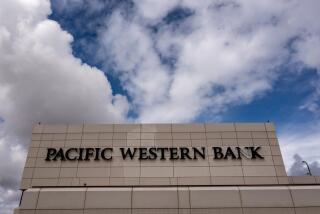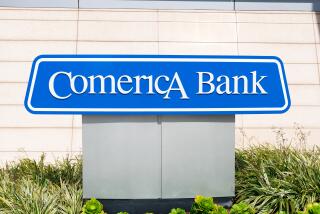Wall St. Split on Chances of B of A Accepting First Interstate Bid
- Share via
SAN FRANCISCO — First Interstate Bancorp’s sweetened $3.4-billion offer to acquire ailing BankAmerica split Wall Street professionals Wednesday, with some betting that BankAmerica’s board will risk the ire of shareholders and spurn the bid and others saying that the merger is now more likely.
All agreed that First Interstate Chairman Joseph J. Pinola’s surprise decision to raise the ante, even before his earlier unsolicited $2.8-billion bid was formally rejected, had caught BankAmerica off balance.
The new First Interstate bid was released to reporters before it was delivered to BankAmerica Chairman A. W. Clausen late Tuesday afternoon. BankAmerica spokesmen had to scramble to get a copy of the letter before drafting a terse, two-sentence response.
The state of siege at the nation’s second-largest banking company became increasingly apparent Wednesday as a spokesman disclosed that a board of directors meeting scheduled to be held in Los Angeles on Sunday and Monday will be moved to San Francisco corporate headquarters. The move will save time and give directors “better access to staff and resources,” the spokesman said.
BankAmerica’s management “needs as much time as possible to analyze” the enhanced bid, he continued, adding: “Whether the required analysis will be completed in time for presentation (to the board) is uncertain.”
Although First Interstate insists that it wants to make a friendly deal, BankAmerica officials consider First Interstate’s overtures unwelcome, if not unfriendly.
“BankAmerica is not interested in negotiating a transaction,” a source knowledgeable about the discussions said. As a result, First Interstate structured its new bid to appeal to shareholders, rather than to BankAmerica’s board and management, the source said.
The new offer would immediately restore suspended dividend payments to BankAmerica’s long-suffering common shareholders.
Meanwhile, BankAmerica’s common stock rose $1.875 a share on very heavy trading, to finish at $15.75 a share, as investors assessed the prospects of the new bid. First Interstate shares fell 12 1/2 cents, to $54.375.
BankAmerica’s closing price was well below the $22 a share that First Interstate says its offer is worth, indicating market skepticism about the value of the deal and its prospects for success.
Independent analysts Wednesday calculated the value of the First Interstate package--a combination of common stock, preferred stock and a bond--at between $20 and $21 a share.
“The market is telling us the deal won’t go through,” said a Wall Street arbitrageur--a trader who speculates in the stock of takeover targets in search of quick profits. “I don’t know of a single arb who has a position,” she added.
Others said the wide gap between BankAmerica’s market price and the value of the First Interstate offer reflected the six months to a year it would take for the merger to receive regulatory approvals and the apparent likelihood that no other suitor for BankAmerica will appear.
Moreover, BankAmerica’s board seems determined to remain independent. On Monday, BankAmerica management agreed to urge the board to reject Pinola’s original offer, and the board was regarded as certain to concur.
“The board can reject the (sweetened) offer on any number of grounds,” another New York arbitrageur said. “They can say the offer is all paper, or that it won’t contribute a lot of capital.”
Still, others said that BankAmerica’s directors are under intense legal, financial and regulatory pressure to come up with a solution to BankAmerica’s woes and may view the enhanced offer from First Interstate as giving them a graceful exit from a difficult situation.
Clausen, the former BankAmerica president who was returned to the top job earlier this month, “didn’t come back to sell the bank, but he’s a businessman,” noted Donald Crowley, a banking industry analyst with Keefe, Bruyette & Woods in San Francisco. “This is a very well-conceived proposal,” he added. “The odds are it will be accepted.”
Crowley blamed the complexity of First Interstate’s offer for the wide gap between First Interstate’s bid and the market price of BankAmerica stock.
The offer involves three types of securities: For each share of BankAmerica common stock, First Interstate would give BankAmerica shareholders 0.22 shares of First Interstate common, a bond with a face value of $3 and a preferred stock issue that will pay a fixed dividend and an additional dividend based on profits of the combined company.
The fixed dividend will be 20 cents a year in 1988-89, 40 cents in 1990-91 and 55 cents every year thereafter. The contingent dividend will equal half of the combined bank’s profit above a certain threshold, which First Interstate said would be about $650 million for the first year after the merger is completed.
First Interstate said the two banks should be able to reach the $650-million target because of First Interstate’s strong earnings--its profits this year probably will exceed $300 million--and considerable savings from asset sales, economies of scale and elimination of overlapping operations.
Goldman, Sachs, First Interstate’s investment advisers, value the preferred stock at $7 a share, although independent analysts say it is worth $1 or $2 less.
First Interstate said the offer as a whole has immediate value to BankAmerica common shareholders because it restores their dividend income, which was halted in January after BankAmerica announced a $338-million loss for 1985. The bank has suffered losses of $600 million so far this year.
First Interstate calculates that its package of securities will pay about $1 a share in dividends the first year, with the payout increasing annually as the preferred share’s fixed dividend grows and the combined bank’s earnings increase.
Despite uncertainty about the value of the new First Interstate offer, major BankAmerica shareholders welcomed the bid and the upward movement in BankAmerica stock. But managers of two major institutions holding big blocks of BankAmerica stock said they probably will sell their holdings before the merger question is decided.
George Reagan, head of equity trading and research for the Texas teacher retirement system, said he is not sure what the First Interstate package of securities is worth. But for shareholders, it represents an improvement on First Interstate’s original bid, he said.
“Our strategy is to spend a little more time analyzing the offer. If it (BankAmerica stock) goes to $18 or $20 (a share), that’s pretty attractive. It gives us an opportunity to take our money elsewhere and put it to better use.”
The $6-billion Texas teachers’ pension fund holds just under 500,000 a million BankAmerica shares, Reagan said. It has sold 487,500 shares in the past six weeks, he added, taking advantage of the spurt that followed First Interstate’s first bid.
David Schafer, president of Schafer Capital Management in New York, said he believes that the First Interstate offer will be turned down by BankAmerica in the next few weeks and that BankAmerica’s share price will fall rapidly.
Schafer’s firm owns about 700,000 shares of BankAmerica stock, having unloaded more than 1 million shares since the end of June.
“I don’t expect it (the First Interstate offer) to get much attention from management,” Schafer said. “If it (BankAmerica stock) goes much higher, I’ll probably sell the rest because I’m concerned that management doesn’t want to do anything. Then the stock will drop back to where it was a month ago.
“I was a lot disappointed that they brought back the old management, which was at least in part responsible for the problems, and in their hard-line attitude that they’re not going to sell the bank. It seems to me they can do more with First Insterstate than they can by going it alone.
“I’ve never been more wrong on a stock than on BankAmerica.”
More to Read
Inside the business of entertainment
The Wide Shot brings you news, analysis and insights on everything from streaming wars to production — and what it all means for the future.
You may occasionally receive promotional content from the Los Angeles Times.










